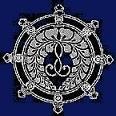In a nutshell
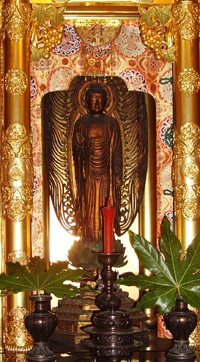 The The Jōdo Shinshū ("True Essence of the Pure Land Way") was founded by Shinran Shōnin in the
13th century. It is a denomination for Buddhist lay people who completely entrust themselves
to the other Power of the Buddha. Although Jōdo Shinshū is the Buddhist denomination with
the most followers in Japan it is quite unknown in the West. One of the first who introduced
Shinran's teachings to Western people was Daisetsu Suzuki (1870-1966), the great transmitter
of Zen Buddhism. From him stems also the English term "Shin Buddhism".
The The Jōdo Shinshū ("True Essence of the Pure Land Way") was founded by Shinran Shōnin in the
13th century. It is a denomination for Buddhist lay people who completely entrust themselves
to the other Power of the Buddha. Although Jōdo Shinshū is the Buddhist denomination with
the most followers in Japan it is quite unknown in the West. One of the first who introduced
Shinran's teachings to Western people was Daisetsu Suzuki (1870-1966), the great transmitter
of Zen Buddhism. From him stems also the English term "Shin Buddhism".
The BGJ-D e.V. (Buddhist Association Jodo Shinshu in Germany [registered association]) is due to German legal definition a "registered association working on public good" ("gemeinnütziger eingetragener Verein") that persues the goal to explain the Jōdo Shinshū within the framework of Buddhism in general and Japanese culture in pariticular, and to make it understandable to people in Germany. The association intends not only to deepen the understandig of Shin Buddhist teachings in Germany, but also is making effort to promote mutual understanding between peoples of different nation and religious conviction. (statute § 2) As a member of two Buddhist umbrella organziations, the German Buddhist Union and the European Buddhist Union, the BGJ-D promotes cooperation between various all Buddhist denominations transmitted to Europe.
Shinran and his View of Buddhism
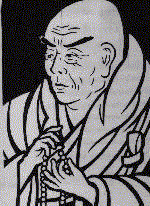 Shinran Shōnin was born 1173 in Hino, a smaller town near Kyōto.
He stemmed from a branch of the famous Fujiwara familiy, which was in his time already on the way
of decline. His mother died when he was seven years old. Under these circumstances his father
decided to receive ordination as a Buddhist monk. The nine year old Shinran also was brought to
a monastery by an uncle to become a novice. The legend knows however, that the abbot postponed
the ordination to the next day, because it was already late in the night, when Shinran arrived.
But little Shinran was dissatified, and looking at an blossoming cherry tree, which
stood in front of the temple gate, he composed the following poem:
Shinran Shōnin was born 1173 in Hino, a smaller town near Kyōto.
He stemmed from a branch of the famous Fujiwara familiy, which was in his time already on the way
of decline. His mother died when he was seven years old. Under these circumstances his father
decided to receive ordination as a Buddhist monk. The nine year old Shinran also was brought to
a monastery by an uncle to become a novice. The legend knows however, that the abbot postponed
the ordination to the next day, because it was already late in the night, when Shinran arrived.
But little Shinran was dissatified, and looking at an blossoming cherry tree, which
stood in front of the temple gate, he composed the following poem:
「明日ありと 思う心の仇桜 夜半に嵐の 吹かぬものかは」
Myōnichi ari to omou kokoro no adasakura yohan ni kaze no fukanu mono kawa
(Reflecting about tomorrow:/
Will these transient cherry blossoms/
in the midst of the night/
not be blown away by the wind?)
For twenty years Shinran lived in one of the most important centres of Japanese Buddhism, the main monastery of the Tendai denomination at Mt. Hiei. With greatest enthusiasm he practiced and studied all kinds of the Buddhist teaching. But more and more he felt the big difference between the reality of the daily life of the monks and the original ideals of the Buddhism. The Buddhist monks of his time were part of a state within the state, because Buddhist monasteries possessed the complete sovereignity within their territory, they had full controll over their serfs and raised even troops. But is this the true intention and purpose of monastic life? Shinran discovered the faults not only in the outer environment. He recognized himself a a child of his time and he was aware, that all their problems also existed in his own heart. Therefore he failed in the "ten thousand practices", he had learned at Mt. Hiei, therefore he seemed to be unable to any realization, if he was honest to himself.
Despaired about himself and his era, in which Buddhist practice seemed already to be impossible, the twenty-nine-year-old Shinran left Mt. Hiei and retreated to a small Kannon temple in Kyōto "to pray concerning his next life". On the 95th day the World saviour Kannon revealed him, that he should turn to Master Hōnen.
At this time people of all social levels - monks and laypeople, men and women - gathered at the outskirts of Kyōto, to listen to Hōnen Shōnin's explanations about the calling of the name of Buddha Amida. For five years Shinran belonged to the inmost circle of Hōnen's disciples and learned from him the Buddhism of Other Power in all its details. As long as he lived, he never regarded himself to be more than a simple disciple of Hōnen.
Hōnen's nembutsu movement was in its openness and religious single-mindedness a challenge to the old elites. In 1207, when Shinran was 35 years old, the nembutsu movement was forbidden by the Imperial court and its monks were divested of their clerical status by the state. Hōnen was exiled to Sanuki, Shinran to Echigo. Both should never meet again.
In Echigo Shinran renounced the monastic rules and married. Since that time he called himself a "stupid baldie" (Gutoku), who is "neither monk nor layman". After he was pardoned Shinran settled with his family in the province Hitachi in East Japan (a region, which is in the north of the present conurbation of Tōkyō). With greatest enthusiam and extraordinary success he devoted himself to the establiment of a local nembutsu community in the coutryside.
His return to the place of his youth may have been a surprise to many of his followers: At the age of seventy he left East Japan to live for the rest of his life in Kyōto, where he occupied himself completely to writing. In 1247 his major work written in Chinese, the Kyōgyōshinshō ("Teaching, Practice, Faith and Realization") was completed. Many scriptures for ordinary followers, which are written in Japanese using the easy Japanese Katakana characters, followed in the later years, inclueding the "Japanese Hymns", which are nowadays often recited during Shin Buddhist celebrations. In his last twenty years Shinran kept in touch with his followers in East Japan with such scriptures and many letters. In retrospect his absence from his followers was of great benefit, because it forced Shinran to write all his works, which are now the spiritual fundament of the Jōdo Shinshū.
Shinran died in old age of 90 years. His followers erected for him a mausoleum in Kyōto, which developed in the long run of time to a place of pilgrimage, and later to an important temple, the Hongwanji.
Shinran's teaching is undoubtely exceptional among the Buddhist doctrines and traditions. Many people feel bewildered when they hear first, that Shinran gave up monastic rules and even Buddhist meditation: How can such a teaching be called Buddhist at all? But this is only a superficious impression. Actually, one should better say that Shinran brought the whole spectrum of Buddhism to a single point: the nembutsu, i.e. the complete entrusting to the Buddha just calling his name. By the way, Shinran's teaching is exclusively based on the Buddhist sūtras and does not - as some people suppose - incorporate local, f.e. Shintoist influences.
Shinran looks at the spiritual development of man radically from the side of the Buddha, the self-power of man is not involved at all. Only if man renounces all his calculation and gives up all his attempts of manipulation, of forcing the salvation for himself or others by his own means, he is capable to entrust fully to the Other-Power of the Buddha. The ultimate expression for this entrusting to the Buddha is to be "aware of the Buddha" (nembutsu) in form of "calling his name" (shōmyō). In the ultimate sense the Nembutsu is nothing else than the Buddha calling himself. Man is just listening to this name-calling and giving response in a kind of reflex, in which the calling, the entrusting and the certainy of birth to the Pure Land coincide.
The Hongwanji
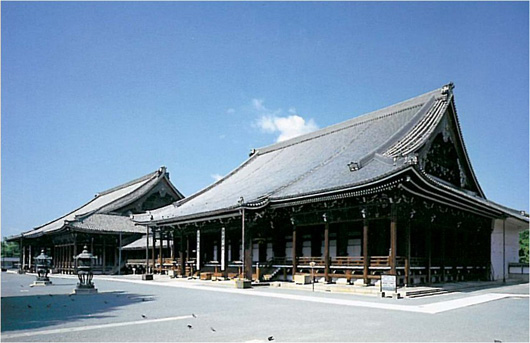 The Hongwanji is the main temple of the Jōdo Shinshū in Kyōto.
(Hongwanji is an archaic transliteration of the name. Recently one can often read the modern
transliteration Honganji.)
The Hongwanji is the main temple of the Jōdo Shinshū in Kyōto.
(Hongwanji is an archaic transliteration of the name. Recently one can often read the modern
transliteration Honganji.)
Only a few of Shinran's followers lived originally in Kyōto. But over the years Shinran's family established sucessfully Shinran's mausoleum as a place of pilgrimage and finally as an important temple. Shinran's daughter Kakushin-ni was the first "caretaker of the mausoleum"(rusushiki), and her sucessors in this position became the head priests of Hongwanji (the so-called Monshu). Even the present (25th) Monshu is a direct descendant of Shinran Shōnin.
It is thanks to the 8th Monshu, Rennyo Shōnin (1415-1499), that Shin Buddhism rised to the biggest Buddhist denomination in Japan. Rennyo was a gifted letter writer and motivator, who steered Jōdo Shinshū safely through one of the darkest ages of Japanese history.
After the Hongwanji had been repeatedly the victim of armed attacks by the monks of other denominations, Rennyo decided to build a temple with fortification on a strategically expedient place (where now the Ōsaka castle is located). For many decades this so-called Ishiyama Hongwanji was a factor of power in Japan. In the 1580ties, when the Hiei-zan monastery was devastated by the brute warlord Oda Nobunaga and thousands of monks were killed, the Ishiyama Hongwanji defied his siege for ten years. Finally the warring parties entered an agreement which granted a safe passage for the defenders, but the Ishiyama Hongwanji was razed to the ground.
This soft solution was not accepted by everybody without critizism. Kyōnyo, the oldest son of the Monshu Kennyo, had been an uncompromising supporter of the continuation of the siege, and therefore had been disinherited by his father. After Kennyo's death the newly established Tokugawa Shogunate used this conflict within the founder's family to devide the Jōdo Shinshū by presenting Kyōnyo his own main temple, which is now the Eastern Hongwanji (Higashi Hongwanji).
Although the schism of Jōdo Shinshū had only political reasons, which are obsolete since hundreds of years, it has never been overcome. Both temples are located in the north of Kyōto central station, and are only two kilometers away from each other. At the first glance they look, at least for the Western visitor, quite similar. But a more thorough look into the details reveals many differences f.e. in the liturgy. Furthermore both temples have established their own academical traditions: The Ryūkoku Universtity belongs to the Western Hongwanji (Nishi Hongwanji), while the Ōtani University is under the patronage of the Eastern Hongwanji.
The Jōdo Shinshū in Germany
Despite the fact that German Shin Buddhism is until now one of the smaller communities within the German Buddhism, it can already look back on more than fifty years of history. Originally founded in Berlin the most important centre is nowadays the Buddhist centre Anjin-dō in Mönchengladbach.
A special enrichment has been the establishment of the EKO temple in Düsseldorf. Although this temple, which is as a part of the Japanese-German culture centre also a local sight, is planned as an oasis for all Buddhists, the equipping of the temple is in all its details typical for the Jōdo Shinshū Hongwanji-ha, and the two resident Japanese priests also belong to this denomination.
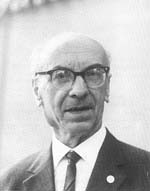 Worth to mention as a pioneer of German and European Shin Buddhism is Rev. Harry Pieper (1907-1978),
who is held in high esteem even in Japan. Born in Berlin he joined in his young years the Buddhist
House in Frohnau (Berlin), which had been founded by Dr. Paul Dahlke and promoted the Theravada
tradition. From 1930 to 1934 (another source says 1938) he was its head, afterwards all Buddhists
activities were forbidden by the Gestapo (Nazi Germany's secret police). In the following years
Harry Pieper met with his group to conspirative Dharma gatherings in the attic story of a Berlin
rented flat. An artistically talented member drawed a picture of the Buddha with chalk on the
wall and Harry Pieper recited the texts of the Pāli Kanon by heart.
Worth to mention as a pioneer of German and European Shin Buddhism is Rev. Harry Pieper (1907-1978),
who is held in high esteem even in Japan. Born in Berlin he joined in his young years the Buddhist
House in Frohnau (Berlin), which had been founded by Dr. Paul Dahlke and promoted the Theravada
tradition. From 1930 to 1934 (another source says 1938) he was its head, afterwards all Buddhists
activities were forbidden by the Gestapo (Nazi Germany's secret police). In the following years
Harry Pieper met with his group to conspirative Dharma gatherings in the attic story of a Berlin
rented flat. An artistically talented member drawed a picture of the Buddha with chalk on the
wall and Harry Pieper recited the texts of the Pāli Kanon by heart.
After he had returned from Russian capitivity in 1946, he founded the "Buddhist Mission", which opened up to the Mahāyāna Buddhism. In this time he became member of the Arya Maitreya Mandala, an Tibetan order founded by Lama Angarika Govinda.
Since 1954 he had contact to the physics professor and convinced Shin Buddhist Osama Yamada, who introduced him step by step into the Shin Buddhist teachings. Still in the same year he met the then Monshu, H.E. Kōshō Ōtani, and impressed by his personality and way of dharma teaching Harry Pieper decided to enter the Pure Land Way.
Soon Harry Pieper made use of his many years of experience with organization and work for Buddhist associations. At January 16th 1956 he founded the "Buddhistische Gemeinschaft Jōdo Shinshū" (Buddhist Association Jōdo Shinshū). In quick succession followed his most important translations into German: Kōshō Ōtani's: "The faith of Jodo Shinshu". Ryuichi Fujii's: "The true meaning of Buddhism", Kyōto 1957 "Buddhist Religion", Kyōto 1958 etc.
In the early sixties Harry Pieper received the ordination to the Shin Buddhist priesthood. Until the end of his life he tried hard to transmit Shin Buddhism to Europe, and many of the most important personalities of Europeas Shin Buddhism are his direct or indirect disciples, f.e. Jean Eracle, the founder of the sangha in Geneve.
In his private life Harry Pieper worked as interpreter especially for the members of American and British armed forces in the devided city. He was married and had two daughters. Buddhism was for him a matter of daily life, not a matter of big talks and nice resolutions. A friend and companion of Harry Pieper, Valentin von Maltzan, characterized him in his eulogy with the words: "His simplicity did not arise from ignorance. He possessed a knowledge of Buddhism. He had, like many Europeans, to find his way among the diversities of Buddhist teachings and doctrines. For him Shin Buddhism was not the supreme among the various paths. Shin Buddhism was simply the right one for him and when he had found it he looked not further."
